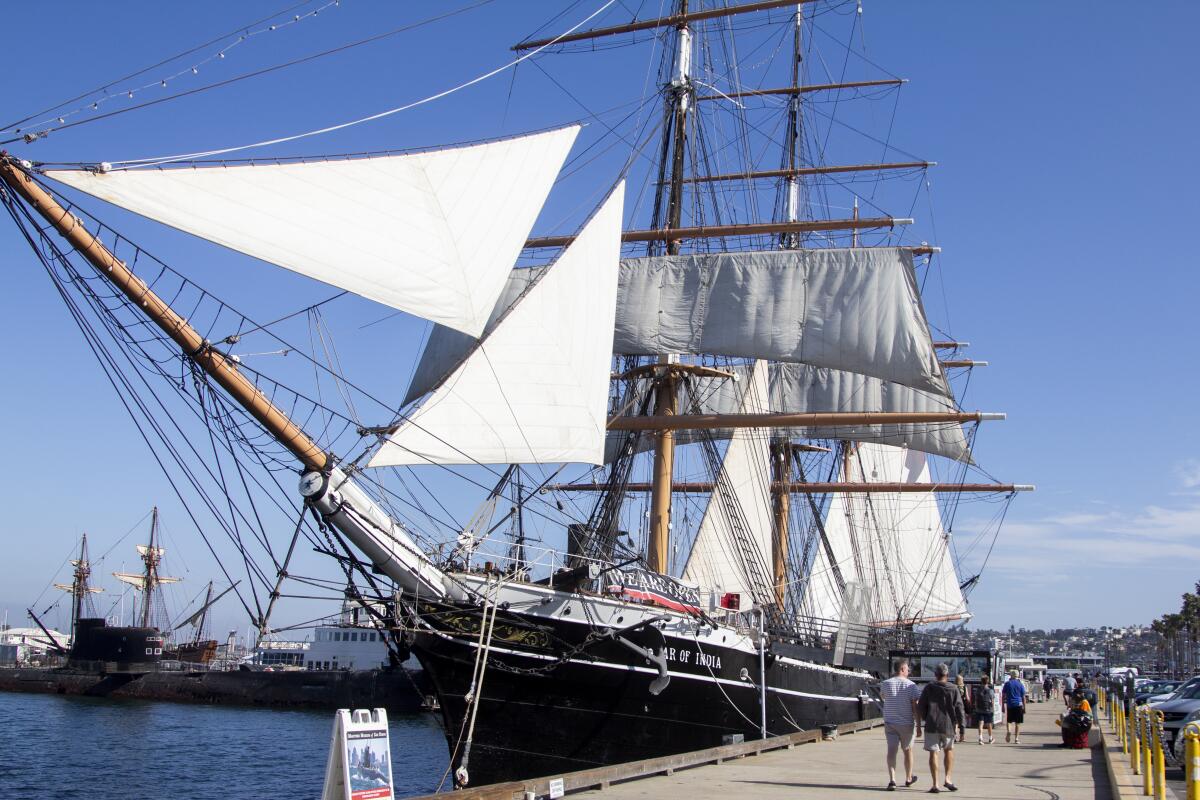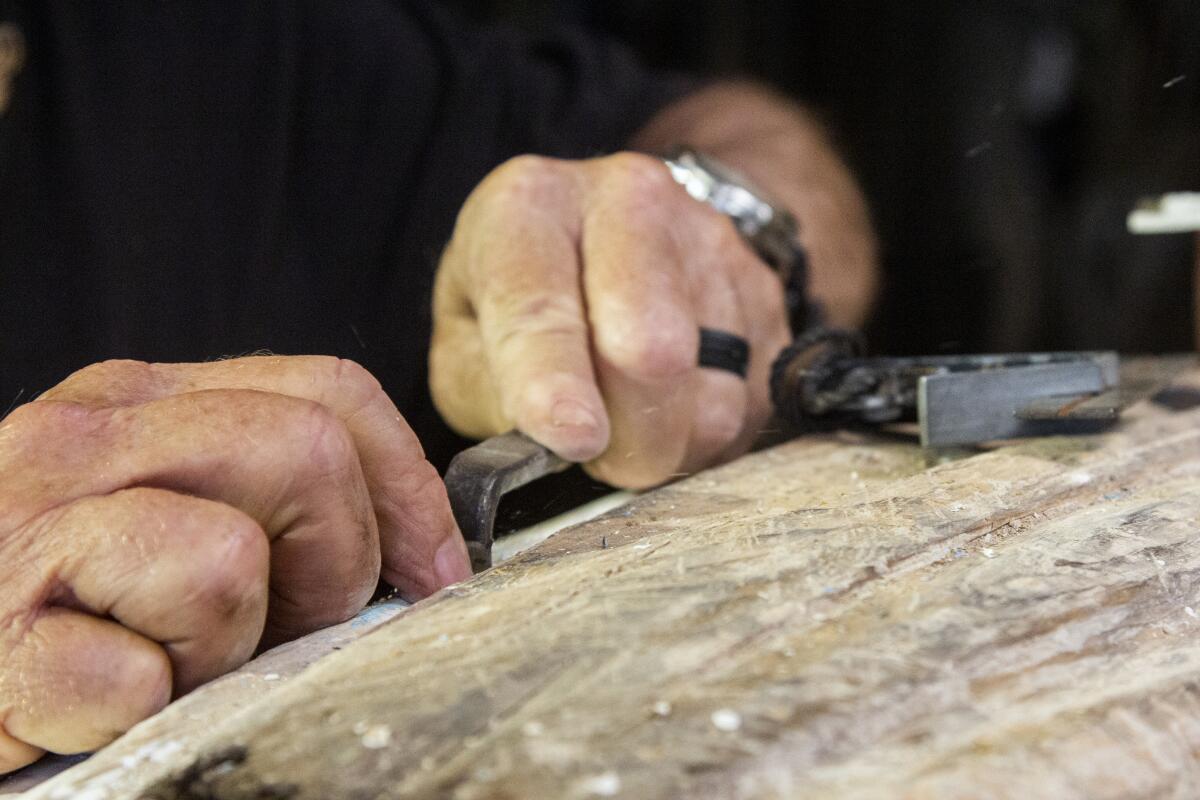Star of India figurehead gets a makeover as San Diego ship nears its 158th anniversary

- Share via
SAN DIEGO — A figurehead on a sailing ship is meant to be a good-luck charm, the forward-facing eyes of a vessel as it slices through churning seas toward distant lands.
The one on San Diego’s historic Star of India has seen a thing or two in its 158 years, not all of them lucky.
Now the figurehead, a 6-foot-long wooden carving of the Greek goddess Euterpe, is taking a break. It’s been removed from the ship’s bowsprit and taken below deck to the main hold to be treated for rot, stripped of old paint and given a fresh coat of white with gold trim.
“It’s an opportunity to bring her back to life, to restore some of what’s been covered up over the years,” said James Davis, director of marine operations for the Maritime Museum of San Diego, which owns the Star. “We’re finding carvings on it we didn’t know were there. So it’s a bit of an archaeology dig too.”

This is the figurehead’s second makeover since the former immigrant transport and salmon-fishing cargo ship was brought to San Diego in the 1920s.
The first, in 1988, stirred debate among historians and preservationists because it involved replacing Euterpe’s left arm, which had been knocked off when it hit another ship in 1884.
Some called the missing arm “a historic scar that was the result of a historic accident.” In a close vote, a majority of the museum’s trustees favored restoration. “We don’t want a floating wreck,” one of them said.
A wood carver made a new arm and attached it. The figurehead was back in place before the ship’s 125th anniversary Nov. 14, 1988.
This time, repair crews are also aiming to have the figurehead restored and on duty again by the anniversary date, Davis said. That gives them about four months to do the often tedious work of removing the old paint and dealing with the wood rot, which creeps in around the areas where the goddess is attached to the bowsprit.
Restoration is being led by George Sutherland, a volunteer and former museum employee who has also been a project manager at local commercial boatyards. He knows about borate treatments for the microorganisms that cause rot and about penetrating epoxies that hold repairs in place.

“It’s a tremendous responsibility to think that you have this treasure in your hands and you need to figure out how to keep her in good shape,” Sutherland said. “It’s a privilege too.”
About half a dozen other people are working with him on the project.
By chance, Sutherland shares a first and last name with the carver in Glasgow, Scotland, who made the figurehead in the 1860s. As far as he knows, they’re not related.
Figureheads are an ancient tradition, with evidence of their use dating from 3,000 BC and the Egyptians, according to Royal Museums Greenwich, a British organization that owns the historic ship Cutty Sark and has one of the largest collections of figureheads in the world.
Shipowners have chosen a variety of subjects for the designs over the years. Sometimes they are images of family members, historic leaders or the owners themselves. In this case, Euterpe was also the name of the ship, at least in the beginning. It got its moniker from one of the nine Greek muses, the goddess of music and poetry. The figurehead has her holding a flute.
As a good-luck charm, Euterpe got off to a rocky start. Its first voyage from England to India included a collision and a mutiny. The second had a cyclone. The first captain died on board and was buried at sea.
After several years of running cargo, the 200-foot-long, iron-hulled ship was bought by a company that transported immigrants to New Zealand. Over the next quarter-century, it made 21 circumnavigations.
In 1901, the Euterpe was purchased by the Alaska Packers Assn. and had its name changed to Star of India. (All the company’s ships were named “Star” of something.) It spent 20 years transporting workers and supplies from California to the fisheries in Alaska, returning with cans of salmon for sale across the U.S.
Retired in 1923, the Star was bought a few years later by the Zoological Society of San Diego, which intended to use it as part of an aquarium and museum. The Great Depression scuttled those plans.
The ship seemed destined for the scrap yard in the 1950s when maritime enthusiasts spearheaded its restoration and began operating it as a floating museum along the downtown waterfront. It’s now a National Historic Landmark.
In 1976 it sailed again, as part of the nation’s bicentennial, and has taken periodic voyages ever since. The museum bills it as the world’s oldest active sailing ship.
That would make Euterpe in all likelihood the oldest active figurehead too — once its makeover is complete.
“It will be an honor,” Davis said, “to bring her back.”
More to Read
Sign up for Essential California
The most important California stories and recommendations in your inbox every morning.
You may occasionally receive promotional content from the Los Angeles Times.














